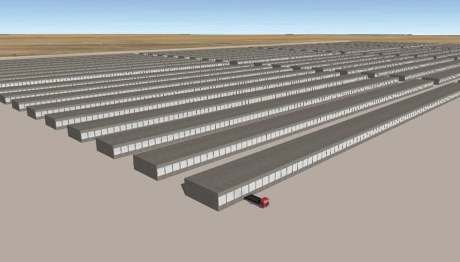UPDATED: This story has been updated to include information on the agreement between Areva Inc and NAC International.
Areva Inc is to take a lead role in designing, constructing and operating a proposed interim storage facility for used nuclear fuel in Texas, after signing an agreement to be Waste Control Specialist's (WCS) exclusive primary subcontractor. NAC International is to work alongside Areva to support the project.
 |
| How the CISF could look (Image: WCS) |
The latest agreement builds on a February 2015 announcement of the two companies' intentions to work together, and covers the design, development, construction, operation and maintenance of the Consolidated Interim Storage Facility (CISF) project. It also includes services to support the transportation of nuclear materials to and from the facility. The companies will work together to support the application process for the facility's licence.
Earlier this year, WCS notified the US Nuclear Regulatory Commission (NRC) that it intends to submit an application for an independent spent fuel storage installation licence by April 2016. The facility would be at Andrews in Texas, where WCS already operates two separately licensed disposal facilities for low-level radioactive wastes.
The Blue Ribbon Commission on America's Nuclear Future recommended in 2012 that at least one interim storage facility should be established while a permanent repository is being developed. The country's administration decided in 2009 not to go ahead with a permanent repository at Yucca Mountain in Nevada, and pending any permanent solution the country's used nuclear fuel is currently in storage at reactor sites.
The CISF would provide above-the-surface storage for used fuel which has already been placed in dry storage casks at the nuclear plant site. The storage casks would be encased in an additional NRC-certified transportation cask and transferred primarily by rail to the facility, where it will be removed from the transportation cask and placed in storage.
WCS and AREVA say their agreement provides them with the chance to offer 'bundled services' to the US Department of Energy for the secure removal, transportation, and interim storage of high-level wastes.
Areva Inc senior vice president Mike McMahon pointed to the company's history of transporting and storing used nuclear fuel at sites around the world. "As debate continues about siting a permanent used fuel repository, the value of the proposed WCS community-supported interim storage facility is a near-term, economically viable option for used fuel management in the United States," he said.
WCS president Rod Baltzer said that the combination of the two companies' experience and expertise could address "the very real need for an immediate interim storage solution for the used nuclear fuel currently stranded at decommissioned sites around the country."
Joining forces
Areva Inc and NAC International are to work together to support the licensing, design, construction and operation of the CISF under a separate agreement signed by the two companies.
Together, the two companies already account for 62% of existing dry storage systems in the USA, including 78% of used nuclear fuel stored at sites where there is no longer an operating nuclear facility. According to the companies, the agreement will ensure that the WCS facility can handle the majority of commercial used nuclear fuel and reactor-related used fuel and high-level waste already in dry storage at US sites while also leveraging their expertise in used nuclear fuel transportation. Additional systems can be added through future license amendments.
Researched and written
by World Nuclear News




_47120.jpg)

_23621.jpg)






